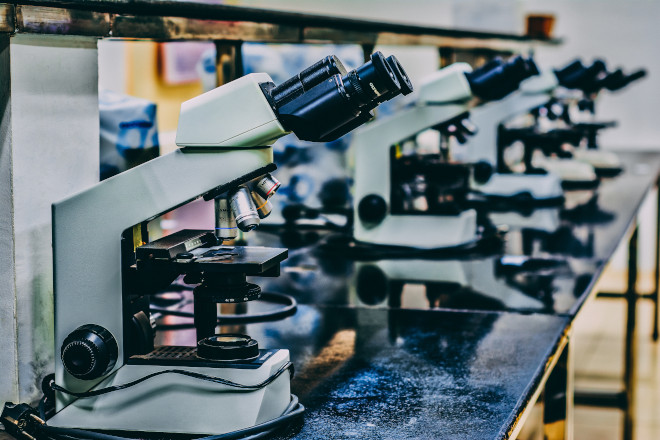
Photo credit: Ousa Chea
The Blavatnik Family Foundation and the New York Academy of Sciences recently announced finalists for the 2019 Blavatnik National Awards for Young Scientists in chemistry, physical sciences and engineering, and life sciences. Of the 31 finalists, 9 or nearly a third are women, up 80% from the National Awards inception in 2014.
For some of these women, their passion for science blossomed early, nurtured by caring relatives and teachers, while professors and colleagues later provided inspiration and guidance for them to fulfill their academic ambitions. Now, they are among the nation’s rising stars in their respective fields.
Here, some of these women share their early discovery of science, the importance of mentorship, and what it means to be a Blavatnik National Awards finalist.
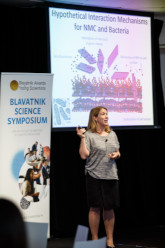 Dr. Haynes presenting at the 2017 Blavatnik Science Symposium at the New York Academy of Sciences.
Dr. Haynes presenting at the 2017 Blavatnik Science Symposium at the New York Academy of Sciences.Dr. Christy Haynes, Professor, University of Minnesota is innovating ways to assess the toxicology of nanoparticles for safer drugs and consumer products.
Christy Haynes remembers – with terror – her first chemistry class. One day, her teacher surprised the students with a combustion test, shooting flames from a laboratory table.
It was the first time she had seen that kind of fiery experiment, and she nearly ran out the classroom for safety. Instead, it laid the groundwork for a lifelong career.
“No one in my family had a scientific background, so I didn’t know what to expect from chemistry,” she said. “But in high school, I quickly learned to love the challenges the subject offered, and the impact a scientist could make.”
While pursuing her doctorate, Haynes had a series of inspiring mentors and she credits Dr. Hilary Godwin (now dean of the University of Washington’s School of Public Health) as an influence. But it wasn’t until after her education that she realized the value of seeing other women balance the responsibilities of a family and a challenging career.
“Throughout my education, I did not consciously think about whether my mentors and colleagues were men or women since both can do great science,” Haynes said. “But I started a family during my tenure period, and that is when I wished I had seen more women do it before.”
As a result, Haynes coordinated a group for women in nanoscience as a platform for support and collaboration.
On the Blavatnik Awards, Haynes is most excited about the cross-fertilization of ideas with other finalists.
“It’s an exciting honor and a great way to learn how other scientists think even if they are in a different field,” she said. “I am happy to be included with many thoughtful people who can influence my thought paradigm.”
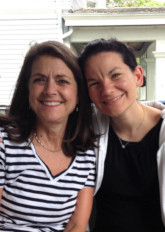 Dr. Balskus with her high school chemistry teacher.
Dr. Balskus with her high school chemistry teacher.Dr. Emily Balskus, Professor, Harvard University is leading breakthrough research on the human gut microbiome and deciphering its role in health and disease.
Emily Balskus jumped at the chance to be a lab assistant in high school. It got her closer to the kinds of experiments that went beyond normal coursework – and helped her to earn money to pay tuition.
“I remember being thrilled by how things worked and understanding this on a molecular level presented a whole new perspective on how everything around me worked,” she said. “Being a lab assistant was one of my first jobs, and it planted a seed in my mind that you could do this as a career.”
What also cemented that ambition were the many strong role models at her all-female school who promoted the value of hard work and academic achievement.
At the top of that list: her chemistry teacher, who recognized Balskus’ talent and made extra time to help her.
“Her guidance made me realize that I could take my interest in chemistry far beyond my high school classroom. She gave me the opportunity to become a lab assistant, and that is a major part of why I am here today.”
Outside of her research, Balskus is focused on helping the field of science becoming more diverse. Balskus said there has been significant progress in attracting women and minorities to science, but there needs to be more help for students to stick with it.
She said Harvard has some graduate classes where the majority of students entering are women but, “We should talk about how to also retain that talent because we do not always see all those students finish the program.”
Balskus is thrilled to be a finalist, but she cannot take all the credit.
“This recognition is a result of our lab’s continuous hard work and commitment to create a collaborative culture,” she said. “We are most successful when we respect all perspectives and foster each other’s development.”
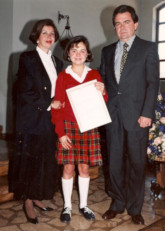 Dr. Rey as a high school student in Colombia.
Dr. Rey as a high school student in Colombia.Dr. Ana Maria Rey, Adjoint Professor, University of Colorado Boulder is exploring some of the most challenging and fundamental problems in quantum mechanics.
As a primary school student in Colombia, Ana Maria Rey learned that the entire universe can be explained by a mathematical equation. And with that understanding, she was hooked on physics.
By high school, she was focused on pursuing a career in physics even though engineering provided more promising opportunities in her home country.
“I did not know any physicists when I was young, but I did know that hard work would lead to new opportunities for me,” Rey said. “I am an example of what one can achieve in science no matter the path.”
In addition, two female mentors played a major role in helping her to become the physicist she is today.
“My undergraduate quantum theory professor was the first female physicist I had ever met,” she said. “She was inspiring and incredibly challenging. My professor would make us throw away our notes at the end of each class, forcing us to absorb the material rather than record it. She gave me confidence to pursue the field even though I did not see a lot of people like me doing it.”
Her other great inspiration was the late Dr. Deborah Jin, an award-winning physicist at the University of Colorado who passed two years ago.
“Her enormous accomplishments at such an early age continues to inspire me,” Rey said. “I still use her advice to this day.”
Being named as a finalist for an award in not new for Rey, who is a former MacArthur Fellow, but this is more than an individual honor for her.
“I am excited to share this honor with my family back in Colombia,” she said. “They are always supportive of my work, and that is a major part of my success.”
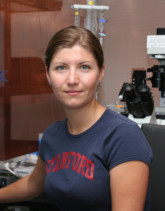 Dr. Gradinaru as a graduate student at Stanford University.
Dr. Gradinaru as a graduate student at Stanford University.Dr. Viviana Gradinaru, Professor, Caltech is inventing methods to track and modulate intact neural circuitry.
In Romania, Viviana Gradinaru and her fellow students were regularly nudged toward science over humanities.
“In Eastern Europe, science was the focus of everyone’s education,” Gradinaru said. “At a very young age, I would participate in Science Olympiads with other students, so I quickly found science to be fun and it felt like a sense of community.”
Throughout childhood, Gradinaru had many great mentors, but not all of them were teachers. Her grandparents first inspired her inclination towards science.
“I grew up in a small, remote village where everyone was a ‘maker.’ My grandparents and the rest of the village often had to come together to create solutions to public problems, and they quickly included me in that process. I learned the value of problem-solving and self-sufficiency from them.”
Gradinaru said she always benefited from the full representation of men and women in Romania’s workforce.
“In Romania, the emphasis on science required full participation from men and women,” she said. “I grew up with many examples of brilliant women teaching and practicing science in my home country.”
Gradinaru is grateful to be recognized as a finalist for the Blavatnik National Awards, which includes scientists from every field.
“Many fellowships and grant programs are focused on one specialty, but I am happy to be a part of this group of scientists conducting all forms of scientific research,” she said. “I’m excited to meet new colleagues and learn from their work.”